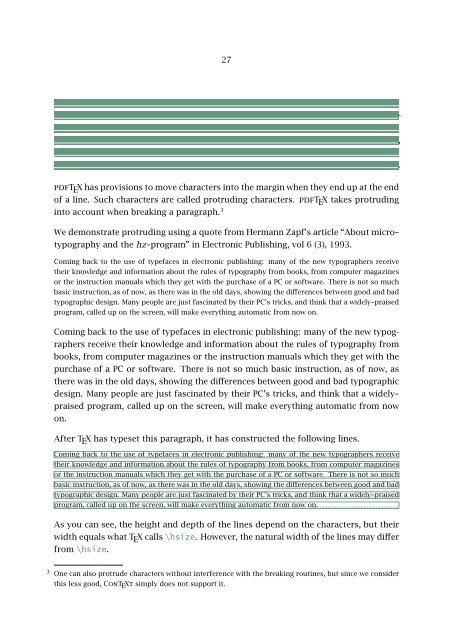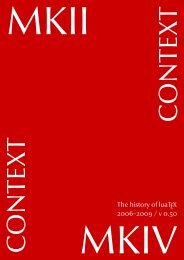font manual - Pragma ADE
font manual - Pragma ADE
font manual - Pragma ADE
You also want an ePaper? Increase the reach of your titles
YUMPU automatically turns print PDFs into web optimized ePapers that Google loves.
27<br />
-<br />
,<br />
.<br />
pdfT E X has provisions to move characters into the margin when they end up at the end<br />
of a line. Such characters are called protruding characters. pdfT E X takes protruding<br />
into account when breaking a paragraph. 3<br />
We demonstrate protruding using a quote from Hermann Zapf’s article “About micro--<br />
typography and the hz--program” in Electronic Publishing, vol 6 (3), 1993.<br />
Coming back to the use of typefaces in electronic publishing: many of the new typographers receive<br />
their knowledge and information about the rules of typography from books, from computer magazines<br />
or the instruction <strong>manual</strong>s which they get with the purchase of a PC or software. There is not so much<br />
basic instruction, as of now, as there was in the old days, showing the differences between good and bad<br />
typographic design. Many people are just fascinated by their PC’s tricks, and think that a widely--praised<br />
program, called up on the screen, will make everything automatic from now on.<br />
Coming back to the use of typefaces in electronic publishing: many of the new typographers<br />
receive their knowledge and information about the rules of typography from<br />
books, from computer magazines or the instruction <strong>manual</strong>s which they get with the<br />
purchase of a PC or software. There is not so much basic instruction, as of now, as<br />
there was in the old days, showing the differences between good and bad typographic<br />
design. Many people are just fascinated by their PC’s tricks, and think that a widely--<br />
praised program, called up on the screen, will make everything automatic from now<br />
on.<br />
After T E X has typeset this paragraph, it has constructed the following lines.<br />
Coming back to the use of typefaces in electronic publishing: many of the new typographers receive<br />
their knowledge and information about the rules of typography from books, from computer magazines<br />
or the instruction <strong>manual</strong>s which they get with the purchase of a PC or software. There is not so much<br />
basic instruction, as of now, as there was in the old days, showing the differences between good and bad<br />
typographic design. Many people are just fascinated by their PC’s tricks, and think that a widely--praised<br />
program, called up on the screen, will make everything automatic from now on.<br />
As you can see, the height and depth of the lines depend on the characters, but their<br />
width equals what T E X calls \hsize. However, the natural width of the lines may differ<br />
from \hsize.<br />
3<br />
One can also protrude characters without interference with the breaking routines, but since we consider<br />
this less good, ConT E Xt simply does not support it.
















